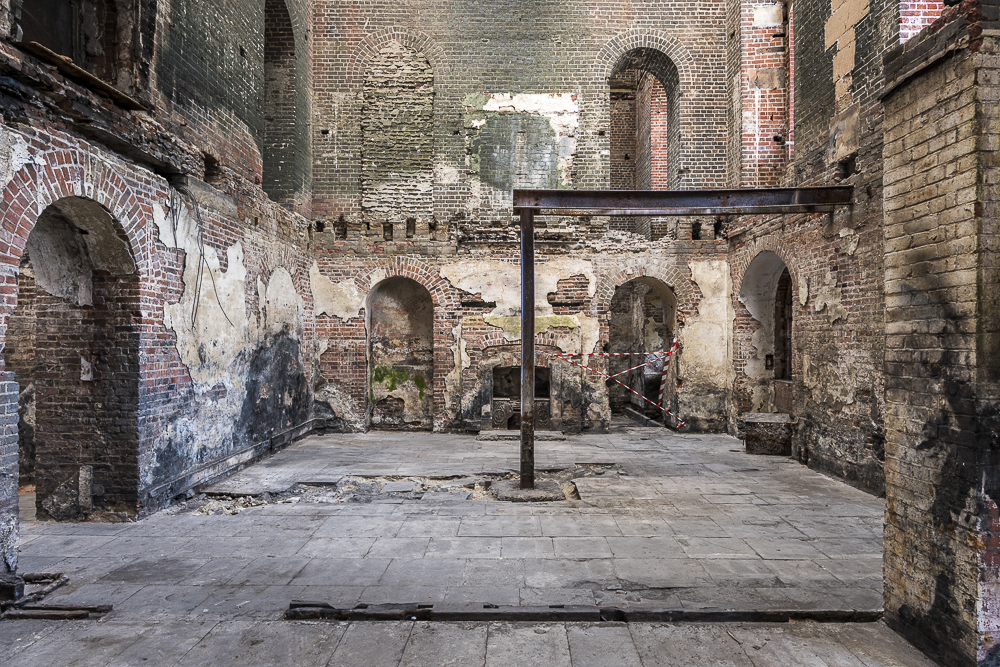In 2015, Clandon Park in Surrey was gutted by fire. The entire roof, staircases and the majority of floors collapsed, leaving a burnt-out brick shell. All eyes were on the building’s custodians, the National Trust, and what they would do next.
Given the extent of the damage and how little of the original interiors actually remained, would the National Trust attempt to recreate the building as it was, leave it as a ruin, or find a new way to honour Clandon’s story?
Evolving plans
The SPAB became involved in discussions about Clandon’s future very soon after the fire and has consistently supported an approach which emphasises conservation and new design.
In the weeks following the fire, the National Trust considered rebuilding Clandon in the style of Uppark. But with time came new research and a greater understanding of the building as it is today. Gradually, the thinking changed.
We’re delighted to see that in many ways the new plans for the future of Clandon reflect a building conservation approach that chimes with the SPAB Approach of sensitive repair.
Sensitive repair
The SPAB Approach is all about the protection of a building’s 'fabric': the material from which a building is constructed and a major way we can interpret a building’s history.
Clandon’s ornate Speakers’ Parlour survived the fire remarkably well and will be repaired, creating a fascinating counterpoint to the other rooms. But where the damage is more severe, the National Trust has chosen to conserve Clandon’s surviving fabric in its fire-damaged state, working with the remarkable, raw beauty it has today. It tells the full story of the building, including the tragic chapter of the 2015 fire.
The appointed architects, Allies and Morrison, say any interventions will be ‘quiet’, preserving the unique qualities of the spaces as they are now and touching the surviving fabric as lightly as possible.
Clandon in its current state also offers an unrivalled training opportunity for architects and craftspeople. As Sophie Chessum, Project Curator, says: ‘It is as close you can get to an early 18th-century building site’.
With its layers peeled back, Clandon is revealing the secrets of how it was built – the materials, techniques, and marks of craftspeople hundreds of years ago all laid bare.
Several SPAB Scholars and Fellows, staff, and trustees have visited the site to learn about the approach and see first-hand the scale of the work involved and the wealth of building history revealed by the fire. We told the story of Clandon in the Spring 2023 issue of the SPAB Magazine.

The brick skeleton shows how the builders adapted their plans as they went. Credit: National Trust.
Good new design
It’s not just the conservation of historic fabric that we care about at the SPAB. Clandon is a fantastic example of using good new design to ensure a building’s continuing usefulness.
Suspended walkways and platforms will give visitors new views and dramatic perspectives through the house where floors once were. A lift will be added to increase accessibility – not something the original architects and craftspeople could consider. A new skylight roof with public terraces will give views of the surrounding countryside while continuing to flood the house with sunlight, throwing sculptures and details into a fresh perspective.
Of course, some people will argue that the whole house should be restored. We feel it would be dishonest to pretend the fire hadn't occurred. While you can recreate something based on photographs, you can never recreate the passage of time within those walls. It’s better to start a new chapter in the building’s long story.
The loss has been a tragedy, but one from which something new and positive can emerge. With its historic fabric conserved, Clandon can now enter a new chapter of its existence – a testament to historic craftsmanship, 21st century capabilities, and the ever-evolving nature of our built heritage.
If you’re a National Trust member, please vote on the proposals for the future of Clandon at the AGM on Saturday 11 November, or vote online by Friday 3 November.
